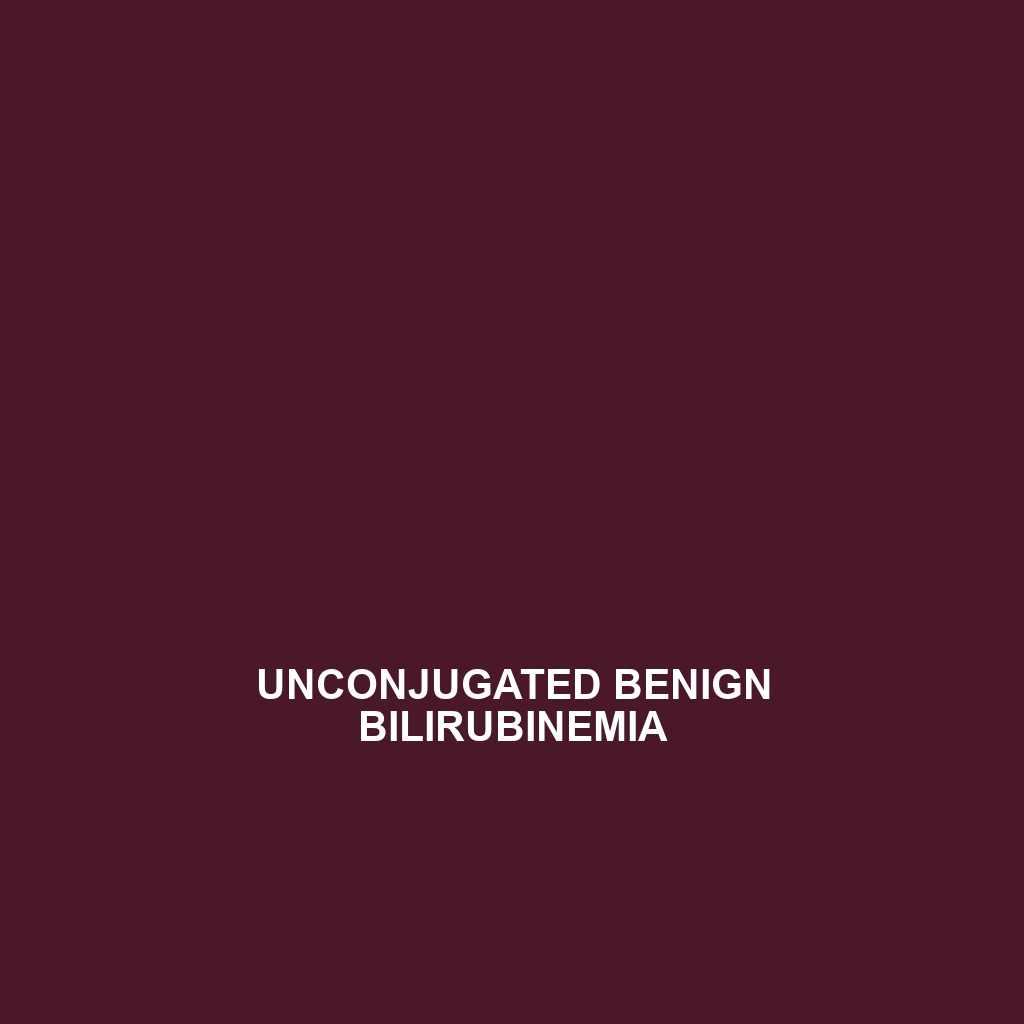Unconjugated Benign Bilirubinemia:
Definition and Description of Unconjugated Benign Bilirubinemia:
Unconjugated benign bilirubinemia is a condition characterized by elevated levels of unconjugated bilirubin in the bloodstream, which occurs when the liver is unable to process bilirubin efficiently. Bilirubin is a byproduct of the breakdown of red blood cells. In benign cases, the elevated levels do not result from serious liver disease, but may arise from the body’s natural variations, increased erythrocyte turnover, or impaired uptake by liver cells. This condition is most common in newborns, where it is often referred to as neonatal jaundice.
Causes of Unconjugated Benign Bilirubinemia:
The causes of unconjugated benign bilirubinemia include several factors:
– **Physiological neonatal jaundice**: Common in infants due to immature liver function.
– **Hemolysis**: Increased breakdown of red blood cells can lead to higher bilirubin levels.
– **Genetic factors**: Conditions like Gilbert’s syndrome, which affects bilirubin metabolism.
– **Excessive bruising or bleeding**: Results in increased bilirubin production from the breakdown of hemoglobin.
Associated Symptoms of Unconjugated Benign Bilirubinemia:
Typically, unconjugated benign bilirubinemia is asymptomatic. However, accompanying symptoms may include:
– Yellowing of the skin and eyes (jaundice)
– Darker urine (due to hydration levels)
– Pale stools (indicative of liver function issues, though less common)
Patients often report no other significant symptoms if the condition is benign.
Diagnosis of Unconjugated Benign Bilirubinemia:
Diagnosis usually involves:
– **Blood tests**: Measuring levels of total and unconjugated bilirubin.
– **Physical examination**: Assessing symptoms related to jaundice.
– **Family history**: Determining genetic predispositions to conditions like Gilbert’s syndrome.
In some cases, more specific tests may be required to rule out underlying liver diseases.
Risk Factors for Unconjugated Benign Bilirubinemia:
Certain individuals are more prone to developing unconjugated benign bilirubinemia, including:
– **Newborns**: Particularly premature infants.
– **Individuals with a family history** of enzyme deficiencies affecting bilirubin metabolism.
– **Pregnant women** with certain health issues that could affect bilirubin levels.
Complications of Unconjugated Benign Bilirubinemia:
While unconjugated benign bilirubinemia is typically non-threatening, potential complications include:
– Chronic jaundice in infants that may require medical intervention.
– Psychological effects associated with noticeable skin discoloration.
Treatment Options for Unconjugated Benign Bilirubinemia:
Treatment options vary:
– **Monitoring**: In most benign cases, no treatment is necessary, and levels normalize naturally.
– **Phototherapy**: Commonly used in newborns to help break down excess bilirubin via ultraviolet light.
– **Hydration**: Staying well-hydrated may assist in managing bilirubin levels.
If an underlying condition is identified, treatment will be directed towards that specific issue.
When to See a Doctor for Unconjugated Benign Bilirubinemia:
It is advisable to seek medical attention if jaundice persists beyond the typical neonatal period, if bilirubin levels are markedly elevated, or if there are accompanying symptoms such as significant fatigue or changes in urine/stool color.
Prevention of Unconjugated Benign Bilirubinemia:
Preventive measures include:
– **Early feeding** for newborns to decrease the risk of jaundice.
– **Routine check-ups** to monitor bilirubin levels in at-risk populations.
– **Genetic counseling** for families with a history of bilirubin metabolism disorders.
Statistics and Prevalence of Unconjugated Benign Bilirubinemia:
Studies indicate that unconjugated benign bilirubinemia is prevalent in approximately 5% to 10% of newborns, with Gilbert’s syndrome affecting 3% to 7% of adults, marking it as a common benign condition.
Personal Stories or Case Studies about Unconjugated Benign Bilirubinemia:
Patients experiencing unconjugated benign bilirubinemia often share how the diagnosis provided relief, as understanding their elevated bilirubin levels was pivotal in decreasing anxiety regarding potential liver diseases. Healthcare professionals typically emphasize the benign nature of the condition, allowing families to feel reassured.
Myths and Misconceptions about Unconjugated Benign Bilirubinemia:
Common myths include the belief that any level of elevated bilirubin indicates serious liver disease. In truth, unconjugated benign bilirubinemia often resolves without intervention and does not typically signify an underlying medical emergency.
Support and Resources for Unconjugated Benign Bilirubinemia:
For further information, patients and families can access various resources. It is essential to engage with support groups or healthcare providers about management strategies. For more information, visit this support page for additional resources and help.
Conclusion about Unconjugated Benign Bilirubinemia:
In summary, unconjugated benign bilirubinemia is commonly observed and often resolves without significant intervention. It is vital for individuals experiencing symptoms to seek medical advice, ensure proper diagnosis, and remain informed about the condition’s implications. Regular monitoring and a supportive network can effectively manage the condition and alleviate potential concerns.
